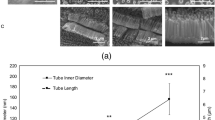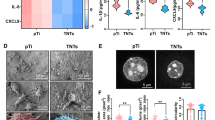Abstract
Recently, TiO2 nanotube layers are widely used in orthopedics and dental applications because of their good promotion effect on bone cells. Furthermore, peptide sequences such as arginine–glycine–aspartic acid are used to modify Ti implant for binding to cell surface integrins through motif. In this study, a cellular adhesive peptide of arginine–glycine–aspartic acid–cysteine (RGDC) was immobilized onto anodized TiO2 nanotubes on Ti to examine its in vitro responses on rat bone marrow stromal cells (BMSCs). Materials were characterized by scanning electron microscopy (SEM) and X-ray photoelectron spectroscopy techniques. High-resolution C1s scans suggested the presence of RGDC on the surface and SEM images confirmed the nanotubes were not destroyed after modification. BMSCs adhesion and osteogenic gene expression were detected in TiO2 nanotube layers with and without RGDC modification by fluorescence microscopy, confocal laser scanning microscopy, SEM, and realtime polymerase chain reaction (Real-time PCR). Results showed that the TiO2 nanotube layers immobilized with RGDC increased BMSCs adhesion compared to nonfunctionalized nanotubes after 4 h of cultivation. Furthermore, the osteogenic gene expression of BMSCs was dramatically enhanced on the TiO2 nanotube layers immobilized with RGDC (10 mM) compared to the TiO2 nanotube layers immobilized with RGDC (1 mM) and non-functionalized anodized Ti. Our results from in vitro study provided evidence that Ti anodized to possess nanotubes and then further functionalized with RGDC should be further studied for the design of better biomedical implant surfaces.








Similar content being viewed by others
References
Linder L, Carlsson A, Marsal L, Bjursten LM, Brånemark PI. Clinical aspects of osseointegration in joint replacement. A histological study of titanium implants. J Bone Joint Surg Br. 1988;70:550–5.
Avila G, Misch K, Galindo-Moreno P, Wang HL. Implant surface treatment using biomimetic agents. Implant Dent. 2009;18:17–26.
Nishimoto SK, Nishimoto M, Park SW, Lee KM, Kim HS, Koh JT, Ong JL, Liu Y, Yang Y. The effect of titanium surface roughening on protein absorption, cell attachment, and cell spreading. Int J Oral Maxillofac Implant. 2008;23:675–80.
Mendonça G, Mendonça DB, Aragão FJ, Cooper LF. Advancing dental implant surface technology: from micron - to nanotopography. Biomaterials. 2008;29:3822–35.
Oh S, Daraio C, Chen LH, Pisanic TR, Finones RR, Jin S. Significantly accelerated osteoblast cell growth on aligned TiO2 nanotubes. J Biomed Mater Res A. 2006;78:97–103.
Bjursten LM, Rasmusson L, Oh S, Smith GC, Brammer KS, Jin S. Titanium dioxide nanotubes enhance bone bonding in vivo. J Biomed Mater Res A. 2010;92:1218–24.
Oh S, Brammer KS, Li YS, Teng D, Enqler AJ, Chien S, Jin S. Stem cell fate dictated solely by altered nanotube dimension. Proc Natl Acad Sci USA. 2009;106:2130–5.
Yu WQ, Jiang XQ, Zhang FQ, Xu L. The effect of anatase TiO2 nanotube layers on MC3T3–E1 preosteoblast adhesion, proliferation, and differentiation. J Biomed Mater Res Part A. 2010;94:1012–22.
Ruoslahti E, Pierschbacher MD. Arg-Gly-Asp: a versatile cell recognition signal. Cell. 1986;44:517–8.
Porté-Durrieu MC, Labrugère C, Villars F, Lefebvre F, Dutoya S, Guette A. Development of RGD peptides grafted onto silica surfaces: XPS characterization and human endothelial cell interactions. J Biomed Mater Res. 1999;46:368–75.
Arnold Marco, Ada Cavalcanti-Adam Elisabetta, Glass Roman. Activation of Integrin Function by nanopatterned adhesive Interfaces. Chem Phys Chem. 2004;5:383–8.
Xiao SJ, Textor M, Spencer ND, Wieland M, Keller B, Sigrist H. Immobilization of the cell-adhesive peptide Arg-Gly-Asp-Cys (RGDC) on titanium surfaces by covalent chemical attachment. J Mater Sci Mater Med. 1997;8:867–72.
Wang D, Ji J, Sun Y, Shen JC, Feng LX, Elisseeff JH. In situ immobilization of proteins and RGD peptide on polyurethane surfaces via poly(ethylene oxide) coupling polymers for human endothelial cell growth. Biomacromolecules. 2002;3:1286–95.
Schliephake H, Scharnweber D, Dard M, Rossler S, Sewing A, Meyer J, Hoogestraat D. Effect of RGD peptide coating of titanium implants on peri-implant bone formation in the alveolar crest. An experimental pilot study in dogs. Clin Oral Implant Res. 2002;13:312–9.
Secchi AG, Grigoriou V, Shapiro IM. RGDS peptides immobilized on titanium alloy stimulate bone cell attachment, differentiation and confer resistance to apoptosis. J Biomed Mater Res A. 2007;83:577–84.
Kim HS, Yang Y, Koh JT, Lee KK, Lee KM, Park SW. Fabrication and characterization of functionally graded nano-micro porous titanium surface by anodizing. J Biomed Mater Res B Appl Biomater. 2009;88:427–35.
Swan EE, Popat KC, Desai TA. Peptide-immobilized nanoporous alumina membranes for enhanced osteoblast adhesion. Biomaterials. 2005;26:1969–76.
Balasundaram Ganesan, Yao Chang, Thomas J. Webster. TiO2 nanotubes functionalized with regions of bone morphogenetic protein-2 increases osteoblast adhesion. J Biomed Mater Res Part A. 2008;84:447–53.
De Giglio E, Cometa S, Calvano CD, Sabbatini L, Zambonin PG, Colucci S, Benedetto AD, Colaianni G. A new titanium biofunctionalized interface based on poly(pyrrole-3-acetic acid) coating: proliferation of osteoblast-like cells and future perspectives. J Mater Sci Mater Med. 2007;18:1781–9.
Hersel U, Dahmen C, Kessler H. RGD modified polymers: biomaterials for stimulated cell adhesion and beyond. Biomaterials. 2003;24:4385–415.
Kantlehner M, Schaffner P, Finsinger D, Meyer J, Jonczyk A, Diefenbach B, Nies B, Holzemann G, Goodman SL. Surface coating with cyclic RGD peptides stimulates osteoblast adhesion and proliferation as well as bone formation. Chem BioChem. 2000;1:107–14.
Jeschke B, Meyer J, Jonczyk A, Kessler H, Adamietz P, Meenen NM, Kantlehner M, Goepfert C, Nies B. RGD-peptides for tissue engineering of articular cartilage. Biomaterials. 2002;23:3455–63.
Lebaron RG, Athanasiou KA. Extracellular matrix cell adhesion peptides: functional applications in orthopedic materials. Tissue Eng. 2000;6:85–103.
van der Flier A, Sonnenberg A. Function and interactions of integrins. Cell Tissue Res. 2001;305:285–98.
Takagi J. Structural basis for ligand recognition by RGD (Arg-Gly-Asp)-dependent integrins. Biochem Soc Trans. 2004;32:403–6.
Massia SP, Hubbell JA. Covalent surface immobilization of Arg-Gly-Asp- and Tyr-Ile-Gly-Ser-Arg-containing peptides to obtain well-defined cell-adhesive substrates. Anal Biochem. 1990;187:292–301.
Anselme K. Osteoblast adhesion on biomaterials. Biomaterials. 2000;21:667–81.
Nelson M, Balasundaram G, Webster TJ. Increased osteoblast adhesion on Ti functionalized with KRSR. J Biomed Mater Res A. 2007;80:602–11.
Pallu S, Bareille R, Dard M, Kessler H, Jonczyk A, Vernizeau M, Amédée-Vilamitjana J. A cyclo peptide activates signaling events and promotes growth and the production of the bone matrix. Peptides. 2003;24:1349–57.
Wang N, Butler JP, Ingber E. Mechanotransduction across the cell surface and through the cytoskeleton. Science. 1993;260:1124–7.
Ruoslahti E. RGD and other recognition sequences for integrins. Annu Rev Cell Dev Biol. 1996;12:697–715.
Acknowledgments
The authors would like to thank Xiu-li Zhang (Oral Bioengineering Lab, Ninth People’s Hospital, School of Medicine, Shanghai Jiao Tong University) for assistance in experiments. This work was supported by Shanghai Leading Academic Discipline Project (Project Number: S30206) and Science and Technology committee of Shanghai (08DZ2271100, 1052nm04300, and 10JC1408600) and Shanghai Leadind Academic Discipline Project (T0202), and National Natural Science Foundation of China (81070866).
Author information
Authors and Affiliations
Corresponding author
Additional information
Xin Cao and Wei-qiang Yu have contributed equally to this work.
Rights and permissions
About this article
Cite this article
Cao, X., Yu, Wq., Qiu, J. et al. RGD peptide immobilized on TiO2 nanotubes for increased bone marrow stromal cells adhesion and osteogenic gene expression. J Mater Sci: Mater Med 23, 527–536 (2012). https://doi.org/10.1007/s10856-011-4479-0
Received:
Accepted:
Published:
Issue Date:
DOI: https://doi.org/10.1007/s10856-011-4479-0




